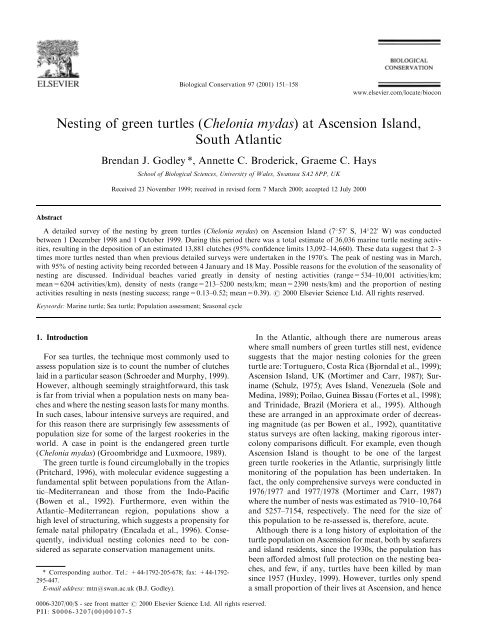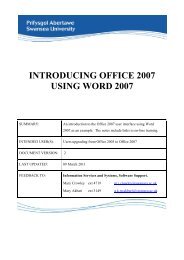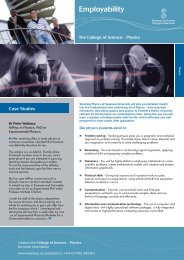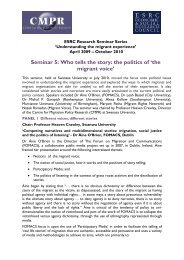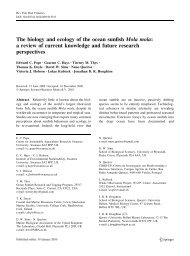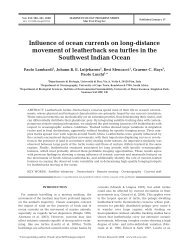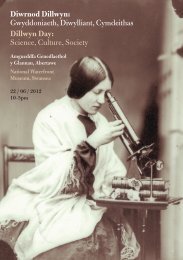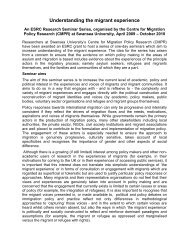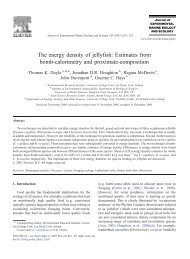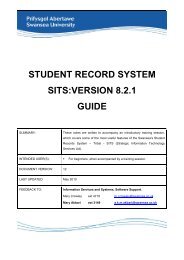Nesting of green turtles (Chelonia mydas) at ... - Seaturtle.org
Nesting of green turtles (Chelonia mydas) at ... - Seaturtle.org
Nesting of green turtles (Chelonia mydas) at ... - Seaturtle.org
You also want an ePaper? Increase the reach of your titles
YUMPU automatically turns print PDFs into web optimized ePapers that Google loves.
Biological Conserv<strong>at</strong>ion 97 (2001) 151±158<br />
www.elsevier.com/loc<strong>at</strong>e/biocon<br />
<strong>Nesting</strong> <strong>of</strong> <strong>green</strong> <strong>turtles</strong> (<strong>Chelonia</strong> <strong>mydas</strong>) <strong>at</strong> Ascension Island,<br />
South Atlantic<br />
Brendan J. Godley *, Annette C. Broderick, Graeme C. Hays<br />
School <strong>of</strong> Biological Sciences, University <strong>of</strong> Wales, Swansea SA2 8PP, UK<br />
Received 23 November 1999; received in revised form 7 March 2000; accepted 12 July 2000<br />
Abstract<br />
A detailed survey <strong>of</strong> the nesting by <strong>green</strong> <strong>turtles</strong> (<strong>Chelonia</strong> <strong>mydas</strong>) on Ascension Island (7 57 0 S, 14 22 0 W) was conducted<br />
between 1 December 1998 and 1 October 1999. During this period there was a total estim<strong>at</strong>e <strong>of</strong> 36,036 marine turtle nesting activities,<br />
resulting in the deposition <strong>of</strong> an estim<strong>at</strong>ed 13,881 clutches (95% con®dence limits 13,092±14,660). These d<strong>at</strong>a suggest th<strong>at</strong> 2±3<br />
times more <strong>turtles</strong> nested than when previous detailed surveys were undertaken in the 1970 0 s. The peak <strong>of</strong> nesting was in March,<br />
with 95% <strong>of</strong> nesting activity being recorded between 4 January and 18 May. Possible reasons for the evolution <strong>of</strong> the seasonality <strong>of</strong><br />
nesting are discussed. Individual beaches varied gre<strong>at</strong>ly in density <strong>of</strong> nesting activities (range=534±10,001 activities/km;<br />
mean=6204 activities/km), density <strong>of</strong> nests (range=213±5200 nests/km; mean=2390 nests/km) and the proportion <strong>of</strong> nesting<br />
activities resulting in nests (nesting success; range=0.13±0.52; mean=0.39). # 2000 Elsevier Science Ltd. All rights reserved.<br />
Keywords: Marine turtle; Sea turtle; Popul<strong>at</strong>ion assessment; Seasonal cycle<br />
1. Introduction<br />
For sea <strong>turtles</strong>, the technique most commonly used to<br />
assess popul<strong>at</strong>ion size is to count the number <strong>of</strong> clutches<br />
laid in a particular season (Schroeder and Murphy, 1999).<br />
However, although seemingly straightforward, this task<br />
is far from trivial when a popul<strong>at</strong>ion nests on many beaches<br />
and where the nesting season lasts for many months.<br />
In such cases, labour intensive surveys are required, and<br />
for this reason there are surprisingly few assessments <strong>of</strong><br />
popul<strong>at</strong>ion size for some <strong>of</strong> the largest rookeries in the<br />
world. A case in point is the endangered <strong>green</strong> turtle<br />
(<strong>Chelonia</strong> <strong>mydas</strong>) (Groombridge and Luxmoore, 1989).<br />
The <strong>green</strong> turtle is found circumglobally in the tropics<br />
(Pritchard, 1996), with molecular evidence suggesting a<br />
fundamental split between popul<strong>at</strong>ions from the Atlantic±Mediterranean<br />
and those from the Indo-Paci®c<br />
(Bowen et al., 1992). Furthermore, even within the<br />
Atlantic±Mediterranean region, popul<strong>at</strong>ions show a<br />
high level <strong>of</strong> structuring, which suggests a propensity for<br />
female n<strong>at</strong>al philop<strong>at</strong>ry (Encalada et al., 1996). Consequently,<br />
individual nesting colonies need to be considered<br />
as separ<strong>at</strong>e conserv<strong>at</strong>ion management units.<br />
* Corresponding author. Tel.: +44-1792-205-678; fax: +44-1792-<br />
295-447.<br />
E-mail address: mtn@swan.ac.uk (B.J. Godley).<br />
In the Atlantic, although there are numerous areas<br />
where small numbers <strong>of</strong> <strong>green</strong> <strong>turtles</strong> still nest, evidence<br />
suggests th<strong>at</strong> the major nesting colonies for the <strong>green</strong><br />
turtle are: Tortuguero, Costa Rica (Bjorndal et al., 1999);<br />
Ascension Island, UK (Mortimer and Carr, 1987); Suriname<br />
(Schulz, 1975); Aves Island, Venezuela (Sole and<br />
Medina, 1989); Poilao, Guinea Bissau (Fortes et al., 1998);<br />
and Trinidade, Brazil (Moriera et al., 1995). Although<br />
these are arranged in an approxim<strong>at</strong>e order <strong>of</strong> decreasing<br />
magnitude (as per Bowen et al., 1992), quantit<strong>at</strong>ive<br />
st<strong>at</strong>us surveys are <strong>of</strong>ten lacking, making rigorous intercolony<br />
comparisons dicult. For example, even though<br />
Ascension Island is thought to be one <strong>of</strong> the largest<br />
<strong>green</strong> turtle rookeries in the Atlantic, surprisingly little<br />
monitoring <strong>of</strong> the popul<strong>at</strong>ion has been undertaken. In<br />
fact, the only comprehensive surveys were conducted in<br />
1976/1977 and 1977/1978 (Mortimer and Carr, 1987)<br />
where the number <strong>of</strong> nests was estim<strong>at</strong>ed as 7910±10,764<br />
and 5257±7154, respectively. The need for the size <strong>of</strong><br />
this popul<strong>at</strong>ion to be re-assessed is, therefore, acute.<br />
Although there is a long history <strong>of</strong> exploit<strong>at</strong>ion <strong>of</strong> the<br />
turtle popul<strong>at</strong>ion on Ascension for me<strong>at</strong>, both by seafarers<br />
and island residents, since the 1930s, the popul<strong>at</strong>ion has<br />
been a€orded almost full protection on the nesting beaches,<br />
and few, if any, <strong>turtles</strong> have been killed by man<br />
since 1957 (Huxley, 1999). However, <strong>turtles</strong> only spend<br />
a small proportion <strong>of</strong> their lives <strong>at</strong> Ascension, and hence<br />
0006-3207/00/$ - see front m<strong>at</strong>ter # 2000 Elsevier Science Ltd. All rights reserved.<br />
PII: S0006-3207(00)00107-5
152 B.J. Godley et al. / Biological Conserv<strong>at</strong>ion 97 (2001) 151±158<br />
mortality occurring away from the island may have<br />
important impacts on the popul<strong>at</strong>ion size.<br />
The life cycle <strong>of</strong> marine <strong>turtles</strong> involves movements<br />
over gre<strong>at</strong> sp<strong>at</strong>ial scales (see Musick and Limpus, 1996<br />
for review), probably taking decades for <strong>turtles</strong> to reach<br />
adulthood. Although adults from the Ascension popul<strong>at</strong>ion<br />
are thought largely to forage in Brazilian coastal<br />
w<strong>at</strong>ers (Carr, 1975; Luschi et al., 1998), the life cycle <strong>of</strong><br />
juveniles involves extended periods in pelagic ocean<br />
current systems (Musick and Limpus, 1996) and they<br />
probably share coastal foraging areas with juveniles<br />
from other popul<strong>at</strong>ions (Lahanas et al., 1998). This life<br />
cycle may expose this popul<strong>at</strong>ion to a number <strong>of</strong> ®sheries.<br />
Although small-scale traditional ®sheries for marine <strong>turtles</strong><br />
once existed in Brazil (Pritchard, 1976), they are no<br />
longer in oper<strong>at</strong>ion (Marcovaldi and Marcovaldi, 1999),<br />
and all marine turtle species are legally protected. Turtles<br />
are, however, still incidentally caught in ®shing<br />
gear. A n<strong>at</strong>ional programme <strong>of</strong> marine turtle conserv<strong>at</strong>ion<br />
now exists in the Brazilian feeding grounds where<br />
the mortality resulting from c<strong>at</strong>ch by artisanal ®sheries<br />
has been reduced (Marcovaldi et al., 1998).<br />
The fundamental goal <strong>of</strong> our study was to upd<strong>at</strong>e<br />
inform<strong>at</strong>ion on the number <strong>of</strong> <strong>green</strong> <strong>turtles</strong> nesting on<br />
Ascension Island and hence to identify whether there<br />
have been any dram<strong>at</strong>ic changes in nesting numbers<br />
over recent decades. We describe the design and implement<strong>at</strong>ion<br />
<strong>of</strong> a rigorous survey regime which has produced<br />
a robust estim<strong>at</strong>e for the number <strong>of</strong> clutches laid<br />
in a season and which will provide a templ<strong>at</strong>e for future<br />
monitoring work.<br />
2. Methods<br />
2.1. Study site<br />
Ascension Island (7 57 0 S, 14 22 0 W) is an isol<strong>at</strong>ed<br />
volcanic peak on the mid-Atlantic ridge th<strong>at</strong> has 32<br />
beaches and coves (Mortimer and Carr, 1987). The<br />
loc<strong>at</strong>ion <strong>of</strong> beaches around the Island are shown in Fig.<br />
1. Many <strong>of</strong> the beaches are backed by uninhabited<br />
beach huts (maximum <strong>of</strong> one per beach) which are<br />
used occasionally by island residents for recre<strong>at</strong>ional<br />
purposes.<br />
2.2. Enumer<strong>at</strong>ion <strong>of</strong> marine turtle nesting activities<br />
Surveys <strong>of</strong> nesting beaches are <strong>of</strong>ten used to assess the<br />
st<strong>at</strong>us <strong>of</strong> marine turtle popul<strong>at</strong>ions (Schroeder and<br />
Murphy, 1999). These utilise the fact th<strong>at</strong> each time a<br />
female turtle emerges from the w<strong>at</strong>er to <strong>at</strong>tempt nesting,<br />
(a ``nesting activity'') it cre<strong>at</strong>es a distinctive set <strong>of</strong> tracks<br />
on the sand: with a track ascending to any aborted digging<br />
<strong>at</strong>tempts or successful nest, and a further track<br />
descending to the sea. By counting tracks to and from<br />
Fig. 1. Map <strong>of</strong> Ascension Island (7 57 0 S, 14 22 0 W) illustr<strong>at</strong>ing marine<br />
turtle nesting beaches. Numbering system follows th<strong>at</strong> <strong>of</strong> Mortimer<br />
and Carr (1987). Key to common names: (1) South West Bay; (2)<br />
Turtleshell; (3) Clarke's; (4) Payne Point; (5) Mitchell's Cove; (6)<br />
Blowhole; (7) POL South; (8) POL North; (9) Deadman's; (10) Fort<br />
Hayes; (11) Ge<strong>org</strong>etown; (12) Long Beach; (13) Comfortless Cove;<br />
(14) English Bay (EB); (15) EB Cove 1; (16) EB Cove 2; (17) EB Cove<br />
3; (18) EB Cove 4; (19) Ladies Loo West; (20) Ladies Loo East; (21)<br />
Porpoise Point (PP) Cove 1; (22) PP Cove 2; (23) PP Cove 3; (24) PP<br />
Cove 4; (25) PP Cove 5; (26) PP Cove 6; (27) Northeast Bay; (28)<br />
Beach Hut; (29) Hannay; (30) Pebbly West; (31) Pebbly East; (32)<br />
Spire. In addition, the major settlement, Ge<strong>org</strong>etown, and the Air-<br />
Field, where meteorological observ<strong>at</strong>ions were made, are marked.<br />
the sea (and dividing by two) it is possible to infer how<br />
many nesting activities have occurred.<br />
Based upon the work <strong>of</strong> Mortimer and Carr (1987),<br />
beaches on Ascension Island were divided into two<br />
classes: those <strong>of</strong> major importance (beaches 1, 12, 27<br />
and 29; Fig. 1); and those <strong>of</strong> minor importance (all<br />
other beaches). From 1 December 1998 until 1 October,<br />
1999, major beaches were visited on 3 successive days<br />
each week. On day 1, all visible tracks were destroyed<br />
using large rakes. On the morning <strong>of</strong> day 2 all new<br />
activities were counted and the associ<strong>at</strong>ed tracks<br />
destroyed. On day 3, again all new activities were<br />
counted. Minor beaches were visited every 1±3 weeks,<br />
but only on 2 successive days, with tracks being raked<br />
on day 1 and new activities being counted on day 2.<br />
An estim<strong>at</strong>e <strong>of</strong> the number <strong>of</strong> turtle activities on each<br />
beach for each inter-survey day was gener<strong>at</strong>ed by interpol<strong>at</strong>ion.<br />
For major beaches, the mean daily count <strong>of</strong><br />
two successive 3-day survey bouts was <strong>at</strong>tributed to<br />
each intervening day. For minor beaches, a mean <strong>of</strong> the<br />
two successive counts was used to gener<strong>at</strong>e an interpol<strong>at</strong>ed<br />
value for intervening days. Thus an estim<strong>at</strong>ed<br />
number <strong>of</strong> activities was <strong>at</strong>tributed to every beach for<br />
each day.<br />
Track raking and counting was undertaken by a diverse<br />
group <strong>of</strong> workers including the authors, local turtle wardens<br />
and volunteers. Several beaches were removed<br />
from the surveying regime as a result <strong>of</strong> both hosting
B.J. Godley et al. / Biological Conserv<strong>at</strong>ion 97 (2001) 151±158 153<br />
negligible nesting activity and being logistically dicult<br />
to survey (beach nos. 13, 18, 19, 20 and 32; Fig. 1). In<br />
addition, although surveyed throughout the season,<br />
beaches 16 and 22 were subsequently deleted from analysis<br />
after having had no clutches deposited throughout<br />
the entire survey period.<br />
2.3. Calcul<strong>at</strong>ion <strong>of</strong> adult nesting success<br />
Turtles do not lay eggs during every nesting activity<br />
and can abort nesting e€orts <strong>at</strong> a number <strong>of</strong> di€erent<br />
stages <strong>of</strong> the nesting process, returning to the sea,<br />
usually to emerge l<strong>at</strong>er on the same or subsequent night.<br />
Experienced observers can assess with a high degree <strong>of</strong><br />
con®dence whether or not an activity has resulted in the<br />
laying <strong>of</strong> a clutch, i.e. ``a nest'' (cf. Bjorndal et al., 1999).<br />
This is comparable with the technique used previously<br />
on Ascension Island (Mortimer and Carr, 1987).<br />
All beaches were visited throughout the season as an<br />
integral part <strong>of</strong> track counting to enumer<strong>at</strong>e ``adult<br />
nesting success'' i.e. the proportion <strong>of</strong> activities which<br />
resulted in a nest. For consistency, this was always carried<br />
out by the authors (BJG and ACB) who were<br />
experienced in this technique (Broderick and Godley,<br />
1996). On a given survey d<strong>at</strong>e, a portion <strong>of</strong> the activities<br />
was assessed. On beaches with low levels <strong>of</strong> nesting this<br />
was all the activities, whereas on those with high levels<br />
<strong>of</strong> nesting a sample <strong>of</strong> 10±20 activities were assessed.<br />
2.4. Calcul<strong>at</strong>ion <strong>of</strong> number <strong>of</strong> clutches laid<br />
For each beach, the number <strong>of</strong> clutches laid on each<br />
day was calcul<strong>at</strong>ed by multiplying the interpol<strong>at</strong>ed or<br />
measured number <strong>of</strong> nesting activities for th<strong>at</strong> day by<br />
the overall nesting success for the season for th<strong>at</strong> beach.<br />
2.5. Additional inform<strong>at</strong>ion<br />
The length <strong>of</strong> each beach was measured along the<br />
high w<strong>at</strong>er mark using a 50 m ®breglass surveying tape<br />
measure. In addition, meteorological observ<strong>at</strong>ions<br />
(daily maximum and minimum air temper<strong>at</strong>ure and<br />
rainfall) taken throughout the study were obtained from<br />
the Meteorological Oce <strong>at</strong> the Ascension Island Air-<br />
®eld. Historic meteorological air temper<strong>at</strong>ure from 1<br />
January 1985±31 December 1997 were also provided.<br />
3. Results<br />
3.1. <strong>Nesting</strong> success<br />
<strong>Nesting</strong> was recorded on 25 beaches and these were<br />
surveyed throughout the season. <strong>Nesting</strong> beaches totalled<br />
5809 m in length, with these individual beaches ranging<br />
from 45 to 965 m (Table 1). In order to produce an<br />
Table 1<br />
Length, nesting success (N success) (95% CL), number <strong>of</strong> activities<br />
(total A), number <strong>of</strong> nests (95% CL), density <strong>of</strong> activities (A/km) and<br />
density <strong>of</strong> nests (nests/km) on each <strong>of</strong> the 25 beaches which had nesting<br />
and were surveyed throughout the season<br />
Beaches<br />
Length<br />
(m)<br />
N<br />
Success<br />
Total<br />
A<br />
Nests A/km Nests/<br />
km<br />
1 530 0.33 4500 1485 8491 2802<br />
(0.29±0.38) (1305±1710)<br />
2 337 0.30 1486 446 4408 1322<br />
(0.19±0.41) (282±609)<br />
3 237 0.38 1485 564 6266 2381<br />
(0.26±0.49) (386±728)<br />
4 150 0.32 1031 330 6873 2199<br />
(0.20±0.43) (206±443)<br />
5 160 0.18 1433 258 8953 1612<br />
(0.09±0.26) (129±373)<br />
6 331 0.33 1462 482 4417 1458<br />
(0.23±0.44) (336±643)<br />
7 428 0.41 1730 709 4042 1657<br />
(0.31±0.51) (536±882)<br />
8 178 0.29 711 206 3994 1158<br />
(0.18±0.40) (128±284)<br />
9 107 0.22 308 68 2886 635<br />
(0.03±0.41) (9±126)<br />
10 78 0.13 166 21 2121 265<br />
(0.01±0.24) (2±40)<br />
11 267 0.36 222 80 830 298<br />
(0.22±0.50) (49±111)<br />
12 965 0.52 9651 5019 10001 5200<br />
(0.46±0.58) (4439±5598)<br />
14 250 0.32 1917 613 7666 2453<br />
(0.24±0.41) (147±251)<br />
15 48 0.40 269 108 5651 2260<br />
(0.15±0.65) (40±175)<br />
17 112 0.35 633 222 5652 1978<br />
(0.21±0.49) (133±310)<br />
21 155 0.38 992 377 6400 2432<br />
(0.26±0.49) (258±486)<br />
23 87 0.40 47 19 534 213<br />
(0.00±0.83) (0±39)<br />
24 478 0.42 176 74 368 155<br />
(0.14±0.70) (25±123)<br />
25 65 0.31 553 171 8547 2649<br />
(0.16±0.45) (88±249)<br />
26 50 0.29 53 15 1060 307<br />
(0.00±0.62) (0±33)<br />
27 334 0.42 3216 1351 9613 4037<br />
(0.37±0.46) (1190±1500)<br />
28 120 0.31 1172 363 9763 3026<br />
(0.21±0.41) (246±481)<br />
29 201 0.32 1986 636 9881 3161<br />
(0.27±0.38) (536±755)<br />
30 96 0.30 681 204 7061 2118<br />
(0.17±0.43) (116±293)<br />
31 45 0.38 159 60 3499 1330<br />
(0.12±0.65) (19±103)<br />
Total 5809 na a 36036 13881 na na<br />
a na, Not applicable.<br />
overall value for the number <strong>of</strong> nests in the entire season,<br />
both the number <strong>of</strong> activities and the nesting success<br />
need to be quanti®ed. For individual beaches the<br />
mean number <strong>of</strong> activities used in the assessment <strong>of</strong>
154 B.J. Godley et al. / Biological Conserv<strong>at</strong>ion 97 (2001) 151±158<br />
nesting success was 99.5 (S.D.= 122; range= 5±444)<br />
while the mean number <strong>of</strong> surveys to collect these d<strong>at</strong>a<br />
was 14.4 (S.D.= 7.5; range= 10±37). The mean values<br />
for nesting success for each beach varied 4-fold, from<br />
0.13 on beach 10 to 0.52 on beach 12 (Table 1), with a<br />
mean <strong>of</strong> 0.33 for all beaches (S.D.= 0.08; n=25 beaches).<br />
The overall nesting success for Ascension Island<br />
calcul<strong>at</strong>ed as total nests divided by total activities was<br />
0.39. When nesting success for the three main beaches<br />
(1, 12, 27) were plotted against time, no trends were<br />
detected.<br />
By multiplying the nest success (p) for each beach by<br />
the respective number <strong>of</strong> activities (a), the number <strong>of</strong><br />
nests on Ascension Island over the season was estim<strong>at</strong>ed<br />
<strong>at</strong> 13,881. The f<strong>at</strong>e <strong>of</strong> a nesting activity is e€ectively a<br />
binomial problem, with outcomes <strong>of</strong> either a ``nest'' or<br />
``no nest''. We used a standard equ<strong>at</strong>ion to calcul<strong>at</strong>e the<br />
variance in the estim<strong>at</strong>e <strong>of</strong> the mean nesting success<br />
value for each beach, i.e. variance=pq/a where q=1 p<br />
(Bailey, 1981), and then from this variance 95% con-<br />
®dence limits (95% CL) were determined. Since the<br />
variance <strong>of</strong> the sum <strong>of</strong> a series <strong>of</strong> estim<strong>at</strong>es is simply the<br />
sum <strong>of</strong> their individual variances, the 95% con®dence<br />
limits on the estim<strong>at</strong>e for the total number <strong>of</strong> nests was<br />
readily determined as 13,092±14,660.<br />
3.2. Magnitude <strong>of</strong> nesting<br />
A total <strong>of</strong> 36,036 marine turtle nesting activities was<br />
estim<strong>at</strong>ed over the entire season, with the number <strong>of</strong><br />
activities per beach ranging from 47 to 9651. Density <strong>of</strong><br />
nesting activities varied widely from 534 to 10,001<br />
activities/km, as did nest density which ranged from 213<br />
to 5200 nests/km. Overall density <strong>of</strong> activities (total<br />
activities/total beach surveyed) was 6204 activities/km<br />
and total nest density (total nests/total beach surveyed)<br />
was 2390 nests/km.<br />
3.3. Sp<strong>at</strong>ial distribution <strong>of</strong> nesting e€ort<br />
Included for comparison are d<strong>at</strong>a from the surveys by<br />
Mortimer and Carr (1987; Table 2), and Mortimer<br />
(1992; from a partial survey carried out in April 1992).<br />
There were many more activities in the 1998/1999 season<br />
than in the two seasons recorded by Mortimer and<br />
Carr (1987), with the total being gre<strong>at</strong>er by an order <strong>of</strong><br />
two and three than in 1976/1977 and 1977/1978 seasons,<br />
respectively. To compare the sp<strong>at</strong>ial vari<strong>at</strong>ion in nesting<br />
e€ort <strong>of</strong> the 1998/1999 season with th<strong>at</strong> <strong>of</strong> previous<br />
surveys (Mortimer and Carr, 1987; Mortimer, 1992),<br />
d<strong>at</strong>a from individual beaches were combined into the<br />
clusters de®ned by Mortimer and Carr (1987; Table 1).<br />
In general, among beach sp<strong>at</strong>ial vari<strong>at</strong>ion was similar in<br />
all seasons. The only marked change since the studies in<br />
1976±1978 appears to be the proportion <strong>of</strong> nesting<br />
occurring on beach number 12.<br />
3.4. Temporal distribution <strong>of</strong> nesting e€ort<br />
The temporal distribution <strong>of</strong> nesting activities is<br />
shown in Fig. 2. Nests were ®rst recorded on 2 December<br />
1998 and continued until the last clutch was laid on<br />
31 August, 1999. The peak <strong>of</strong> nesting was in March with<br />
90% <strong>of</strong> nesting occurring between 13 January and 7<br />
May 1999 and 95% <strong>of</strong> nesting recorded between 4 January<br />
and 18 May 1999.<br />
We used stepwise multiple regression to investig<strong>at</strong>e<br />
the rel<strong>at</strong>ionship between the available we<strong>at</strong>her parameters<br />
(maximum temper<strong>at</strong>ure ( C), minimum temper<strong>at</strong>ure<br />
( C), rainfall (mm)) recorded on each day (2<br />
December 1998 to 31 August 1999) and the estim<strong>at</strong>ed<br />
number <strong>of</strong> nests for th<strong>at</strong> day on the whole island. The<br />
most signi®cant variable was maximum daily temper<strong>at</strong>ure<br />
(r 2 =0.58) with a model including temper<strong>at</strong>ure and<br />
rainfall explaining slightly more <strong>of</strong> the variance<br />
Table 2<br />
Estim<strong>at</strong>ed number <strong>of</strong> activities recorded in the 1998/1999 season in comparison with d<strong>at</strong>a collected by Mortimer and Carr (1987) in the 1976/1977<br />
and 1977/1978 seasons. In addition, d<strong>at</strong>a from the partial survey carried out by Mortimer (1992) are included<br />
Beaches 1976/1977 1977/1978 1991/1992 1998/1999 c<br />
1 2793 (15.4) a 2195 (18.2) (13.1) 4500 (12.5)<br />
2±5 1821 (10.0) 1569 (13.0) (11.3) 5434 (15.1)<br />
6±11 2453 (13.5) 1428 (11.8) (17.0) 4599 (12.8)<br />
12 3118 (17.1) 1760 (14.6) (28.1) 9651 (26.8)<br />
14±20 1341 (7.4) 783 (6.5) (1.4) 2819 (7.8)<br />
21±26 976 (5.4) 822 (6.8) (5.5) 1820 (5.1)<br />
27 2703 (14.9) 1469 (12.1) (12.5) 3216 (8.9)<br />
28 804 (4.4) 420 (3.5) (1.8) 1172 (3.2)<br />
29 1743 (9.6) 1191 (9.8) (6.9) 1986 (5.5)<br />
30±32 440 (2.4) 456 (3.8) (2.6) 839 (2.3)<br />
Total 18,192 12,093 na b 36,036<br />
a Numbers in parentheses denote the percentage <strong>of</strong> the total for the season.<br />
b na, Not applicable.<br />
c It should be noted th<strong>at</strong> in 1998/1999, d<strong>at</strong>a were not included from beaches 13, 18, 19, 20 and 32 (see Section 2).
B.J. Godley et al. / Biological Conserv<strong>at</strong>ion 97 (2001) 151±158 155<br />
Fig. 2. Temporal distribution <strong>of</strong> nesting activities <strong>of</strong> <strong>green</strong> <strong>turtles</strong> on<br />
Ascension Island during the 1998/1999 season. For each beach, the<br />
number <strong>of</strong> nests was subsequently calcul<strong>at</strong>ed by multiplying the actual<br />
or interpol<strong>at</strong>ed number <strong>of</strong> nesting activities for th<strong>at</strong> day and the overall<br />
nesting success for the season on th<strong>at</strong> beach.<br />
Fig. 4. Monthly mean sand temper<strong>at</strong>ure on beach 12 (January 1985±<br />
December 1997) predicted using the rel<strong>at</strong>ionship between monthly<br />
mean maximum air temper<strong>at</strong>ure measured <strong>at</strong> the Ascension Island<br />
Air®eld and the sand temper<strong>at</strong>ure <strong>at</strong> nest depth on th<strong>at</strong> beach (Hays et<br />
al., 1999).<br />
(r 2 =0.59). Overall, as air temper<strong>at</strong>ure increased so did<br />
the daily number <strong>of</strong> nests (Fig. 3). To investig<strong>at</strong>e the<br />
possible e€ect <strong>of</strong> rainfall on nesting success, for each 10<br />
day period, mean rainfall and mean nesting success were<br />
compared using regression analysis and no signi®cant<br />
rel<strong>at</strong>ionship was found (F 1,15 =0.03, p=0.87, r 2 =0.02).<br />
The close link between air temper<strong>at</strong>ure and sand<br />
temper<strong>at</strong>ure <strong>at</strong> nest depth has previously been described<br />
for Ascension Island (Hays et al., 1999). This rel<strong>at</strong>ionship<br />
(mean monthly sand temper<strong>at</strong>ure ( C) on Long<br />
Beach =1.6+0.908 mean monthly daily maximum<br />
temper<strong>at</strong>ure; F 1,10 =498, p
156 B.J. Godley et al. / Biological Conserv<strong>at</strong>ion 97 (2001) 151±158<br />
4.2. Magnitude <strong>of</strong> nesting<br />
Our methodology is comparable to th<strong>at</strong> used by<br />
Mortimer and Carr (1987), and, therefore, it is evident<br />
th<strong>at</strong> 2±3 times more <strong>turtles</strong> nested in 1998/1999 than in<br />
the surveys in the 1970 0 s. This is worthy <strong>of</strong> cautious<br />
optimism regarding the st<strong>at</strong>us <strong>of</strong> the Ascension Island<br />
nesting popul<strong>at</strong>ion given th<strong>at</strong> many popul<strong>at</strong>ions are<br />
thought to be depleted or endangered (King, 1982). For<br />
some sea turtle popul<strong>at</strong>ions, such as the <strong>green</strong> <strong>turtles</strong><br />
nesting in Pakistan (Asrar, 1999) or le<strong>at</strong>herback <strong>turtles</strong><br />
in Malaysia (Chan and Liew, 1996) and Mexico (Sarti et<br />
al., 1996), there have been precipitous declines in nesting<br />
numbers in recent decades. This is certainly not the<br />
case for <strong>green</strong> <strong>turtles</strong> on Ascension Island. However,<br />
<strong>green</strong> turtle nesting numbers are prone to high levels <strong>of</strong><br />
inter-annual variability (Carr et al., 1978; Schulz, 1982;<br />
Limpus and Nicholas, 1987), and hence continued<br />
monitoring e€orts are necessary in order to identify<br />
whether there have been subtle changes in the size <strong>of</strong> the<br />
Ascension Island popul<strong>at</strong>ion. For cheloniids, such<br />
changes may be identi®ed by intermittent monitoring<br />
over many decades (Hall et al., 1999) and, as such, our<br />
results will become an important component in future<br />
monitoring studies on Ascension Island.<br />
4.3. Sp<strong>at</strong>ial vari<strong>at</strong>ion in nesting e€ort<br />
It is clear th<strong>at</strong> the general present-day distribution <strong>of</strong><br />
nesting is similar to th<strong>at</strong> recorded in the 1970s, with the<br />
same major beaches still holding a large proportion <strong>of</strong><br />
nesting.<br />
4.4. Temporal distribution <strong>of</strong> nesting e€ort<br />
The timing <strong>of</strong> the 1998/1999 season as described is<br />
broadly similar to th<strong>at</strong> presented by previous authors in<br />
preliminary studies (Carr and Hirth, 1962; Carr, 1975)<br />
and extremely similar to the detailed ®ndings <strong>of</strong> Mortimer<br />
and Carr (1987). From the shape <strong>of</strong> the curve <strong>of</strong> the<br />
temporal distribution <strong>of</strong> nesting (Fig. 2) it appears th<strong>at</strong><br />
although not all nests were recorded by beginning surveying<br />
on 1 December a negligible proportion was missed.<br />
This was con®rmed by anecdotal accounts by<br />
Island residents who suggested there had been occasional<br />
nests in November but th<strong>at</strong> nesting in October<br />
had not been observed.<br />
For most popul<strong>at</strong>ions <strong>of</strong> sea turtle, nesting occurs in a<br />
distinct season, usually in the warmest months (Miller,<br />
1996). The reasons for this seasonality are rarely considered<br />
explicitly. On Ascension, Mortimer and Carr<br />
(1987) noted th<strong>at</strong> the turtle nesting season coincided<br />
with the time <strong>of</strong> the year when both highest rainfalls and<br />
highest temper<strong>at</strong>ures were recorded. They suggested<br />
th<strong>at</strong> the timing was adaptive in th<strong>at</strong> <strong>turtles</strong> have diculty<br />
constructing nests in dry sand, thus by nesting in<br />
the wettest part <strong>of</strong> the year, digging would be facilit<strong>at</strong>ed.<br />
If this was the case, nesting success might be expected to<br />
be higher <strong>at</strong> times <strong>of</strong> peak nesting. No evidence was<br />
found to support the hypothesis th<strong>at</strong> the seasonality <strong>of</strong><br />
marine turtle nesting is adaptively linked to higher<br />
rainfall to facilit<strong>at</strong>e nesting as suggested by Mortimer<br />
and Carr (1987). First, nesting success did not vary<br />
during the season. Second, nesting success was not<br />
rel<strong>at</strong>ed to rainfall and third, rainfall only explained a<br />
small proportion <strong>of</strong> the variance in nest numbers in our<br />
multiple regression. We would therefore suggest th<strong>at</strong> prevailing<br />
temper<strong>at</strong>ures are more likely a factor in the explan<strong>at</strong>ion<br />
<strong>of</strong> the timing <strong>of</strong> the nesting season. Mortimer and<br />
Carr (1987) presented d<strong>at</strong>a illustr<strong>at</strong>ing the fact th<strong>at</strong><br />
March and April were the months with most rain. The<br />
variance shown in the mean monthly rainfall for these<br />
months was very high. This is possibly due to the fact<br />
th<strong>at</strong> the magnitude <strong>of</strong> rainfall in these months is dependent<br />
on occasional extreme rainstorms which do not<br />
occur every year.<br />
We found a strong correl<strong>at</strong>ion between the magnitude<br />
<strong>of</strong> nesting and air temper<strong>at</strong>ure. By using the close rel<strong>at</strong>ionship<br />
between air temper<strong>at</strong>ure and sand temper<strong>at</strong>ure<br />
<strong>at</strong> nest depth previously described by Hays et al. (1999),<br />
Fig. 4 shows th<strong>at</strong> during the months <strong>of</strong> negligible or no<br />
nesting (July±October), sand temper<strong>at</strong>ures will exist<br />
which are close to the lower limit <strong>of</strong> the thermal tolerance<br />
range for marine turtle embryos (25±27 C; Ackerman,<br />
1996). On beach 12 most monthly means <strong>of</strong> sand<br />
temper<strong>at</strong>ure during the nesting season <strong>at</strong> nest depth lie<br />
within this range. Turtles may have evolved to nest<br />
during the time <strong>of</strong> highest sand temper<strong>at</strong>ures avoiding<br />
the months where, certainly on beach 12 and other<br />
beaches <strong>of</strong> a high albedo (Hays et al., 1995, 1999), nest<br />
temper<strong>at</strong>ures may get too low.<br />
4.5. Conclusion<br />
In summary, our observ<strong>at</strong>ions con®rm the regional<br />
importance <strong>of</strong> the <strong>green</strong> <strong>turtles</strong> nesting on Ascension<br />
Island and suggest th<strong>at</strong> the st<strong>at</strong>us <strong>of</strong> the popul<strong>at</strong>ion is<br />
favourable. It is clear th<strong>at</strong> this remains a key rookery for<br />
<strong>green</strong> <strong>turtles</strong> in the Atlantic. However, additional monitoring<br />
is clearly necessary to identify whether long term<br />
trends in popul<strong>at</strong>ion size are occurring. With the methodology<br />
presented here, accur<strong>at</strong>e estim<strong>at</strong>es <strong>of</strong> nesting<br />
popul<strong>at</strong>ion size can be obtained which will be directly<br />
comparable among years and popul<strong>at</strong>ions.<br />
Acknowledgements<br />
This work was funded by a grant to GCH from the<br />
Darwin Initi<strong>at</strong>ive for the Survival <strong>of</strong> the Species (UK<br />
Department <strong>of</strong> Environment, Transport and the<br />
Regions; DETR) and was carried out in conjunction
B.J. Godley et al. / Biological Conserv<strong>at</strong>ion 97 (2001) 151±158 157<br />
with the Ascension Island Administr<strong>at</strong>or, HH Roger<br />
Huxley. The ®eld work would not have been possible<br />
without the e€orts <strong>of</strong> Darwin Initi<strong>at</strong>ive Turtle Wardens:<br />
Robert Frauenstein, Fiona Glen, Jason Tim, Donald<br />
Stevens, Steve Thomas, Deon Yon and the help <strong>of</strong> the<br />
regular volunteer track rakers: Dudley Bowling, Niddy<br />
Huxley, Je€ Lowdermilk, Kyla Turton and those many<br />
others who helped out on occasion. We are gr<strong>at</strong>eful for<br />
the additional logistical support <strong>of</strong> Ascension Island<br />
Services, Cable and Wireless, Computer Services Raytheon,<br />
First Ascension Scout Group, Johnny Hobson,<br />
Merlin Communic<strong>at</strong>ions Ltd., Dave Rayney, Reed<br />
Family, Royal Air Force and the United St<strong>at</strong>es Air<br />
Force. Many thanks to the Meteorological Oce <strong>at</strong> the<br />
Ascension Island Air®eld for providing d<strong>at</strong>a. This<br />
manuscript was improved as the result <strong>of</strong> comments<br />
from M<strong>at</strong>thew Godfrey, Jeanne Mortimer and one<br />
anonymous reviewer.<br />
References<br />
Asrar, F.F., 1999. Decline <strong>of</strong> marine turtle nesting popul<strong>at</strong>ions in<br />
Pakistan. Marine Turtle Newsletter 83, 13±14.<br />
Ackerman, R.A., 1996. The nest environment and the embryonic<br />
development <strong>of</strong> sea <strong>turtles</strong>. In: Lutz, P.L., Musick, J.A. (Eds.), The<br />
Biology <strong>of</strong> Sea Turtles. CRC Press, Boca R<strong>at</strong>on, pp. 83±106.<br />
Bailey, N.T.J., 1981. St<strong>at</strong>istical methods in biology. Hodder and<br />
Stoughton, London (216 pp.).<br />
Bjorndal, K.A., Whetherall, J.A., Bolten, A., Mortimer, J.A., 1999.<br />
Twenty six years <strong>of</strong> <strong>green</strong> turtle nesting <strong>at</strong> Tortuguero Costa Rica:<br />
an encouraging trend. Conserv<strong>at</strong>ion Biology 13, 126±134.<br />
Bowen, B.W., Meylan, A.B., Ross, J.P., Limpus, C.J., Balazs, G.H.,<br />
Avise, J.C., 1992. Global popul<strong>at</strong>ion structure and n<strong>at</strong>ural history<br />
<strong>of</strong> the <strong>green</strong> turtle (<strong>Chelonia</strong> <strong>mydas</strong>) in terms <strong>of</strong> m<strong>at</strong>ernal phylogeny.<br />
Evolution 46, 865±881.<br />
Broderick, A.C., Godley, B.J., 1996. Popul<strong>at</strong>ion and nesting ecology<br />
<strong>of</strong> the <strong>green</strong> turtle, <strong>Chelonia</strong> <strong>mydas</strong>, and loggerhead turtle, Caretta<br />
caretta, in northern Cyprus.. Zoology in the Middle East. 13, 27±<br />
46.<br />
Carr, A., 1975. The Ascension Island <strong>green</strong> turtle colony. Copeia 1975,<br />
547±555.<br />
Carr, A., Hirth, H., 1962. The ecology and migr<strong>at</strong>ions <strong>of</strong> sea <strong>turtles</strong><br />
5:Compar<strong>at</strong>ive fe<strong>at</strong>ures <strong>of</strong> isol<strong>at</strong>ed <strong>green</strong> turtle colonies. American<br />
Museum Novit<strong>at</strong>es 2091, 1±41.<br />
Carr, A.F., Carr, M.H., Meylan, A.B., 1978. The ecology and migr<strong>at</strong>ions<br />
<strong>of</strong> sea <strong>turtles</strong> 7: the west Caribbean <strong>green</strong> turtle colony. Bulletin<br />
<strong>of</strong> the American Museum <strong>of</strong> N<strong>at</strong>ural History. 162, 1±48.<br />
Chan, E.H., Liew, H.C., 1996. Decline <strong>of</strong> the le<strong>at</strong>herback popul<strong>at</strong>ion<br />
in Terengganu, Malaysia, 1956±1995. <strong>Chelonia</strong>n Conserv<strong>at</strong>ion and<br />
Biology 2, 196±203.<br />
Encalada, S.E., Lahanas, P.N., Bjorndal, K.A., Bolten, A.B., Miyamoto,<br />
M.M., Bowen, B.W., 1996. Phylogeography and popul<strong>at</strong>ion<br />
structure <strong>of</strong> Atlantic and Mediterranean <strong>green</strong> turtle <strong>Chelonia</strong><br />
<strong>mydas</strong>: a mitochondrial DNA control region sequence assessment.<br />
Molecular Ecology 5, 473±483.<br />
Fortes, O., Pires, A.J., Bellini, C., 1998. Green turtle, <strong>Chelonia</strong> <strong>mydas</strong><br />
in the island <strong>of</strong> Poilao, Bolama-Bijagos Archipelago, Guinea-Bissau,<br />
West Africa. Marine Turtle Newsletter 80, 8±10.<br />
Groombridge, B., Luxmoore, R., 1989. The Green Turtle and<br />
Hawksbill (Reptilia: Cheloniidae): World St<strong>at</strong>us, Exploit<strong>at</strong>ion and<br />
Trade. CITES Secretari<strong>at</strong>, Lausanne, Switzerland (601 pp.).<br />
Hall, R.J., Henry, P.F.P., Bunck, C.M., 1999. Fifty-year trends in a<br />
box turtle popul<strong>at</strong>ion in Maryland. Biological Conserv<strong>at</strong>ion 88,<br />
165±172.<br />
Hays, G.C., Godley, B.J., Broderick, A.C., 1999. Long-term thermal<br />
conditions on the nesting beaches <strong>of</strong> <strong>green</strong> <strong>turtles</strong> on Ascension<br />
Island. Marine Ecology Progress Series 185, 297±299.<br />
Hays, G.C., Adams, C.R., Mortimer, J.A., Speakman, J.R., 1995.<br />
Inter- and intra-beach thermal vari<strong>at</strong>ion for <strong>green</strong> turtle nests on<br />
Ascension Island, South Atlantic. Journal <strong>of</strong> the Marine Biological<br />
Associ<strong>at</strong>ion UK. 75, 405±411.<br />
Huxley, R., 1999. Historical overview <strong>of</strong> marine turtle exploit<strong>at</strong>ion on<br />
Ascension Island, South Atlantic, 1999. Marine Turtle Newsletter.<br />
84, 7±9.<br />
King, W.F., 1982. Historical review <strong>of</strong> the decline <strong>of</strong> the <strong>green</strong> turtle<br />
and the hawksbill. In: Bjorndal, K.A. (Ed.), Biology and Conserv<strong>at</strong>ion<br />
<strong>of</strong> Sea Turtles. Smithsonian Institute Press, Washington DC,<br />
pp. 183±188.<br />
Lahanas, P.N., Bjorndal, K.A., Bolten, A.B., Encalada, S.E., Miyamoto,<br />
M.M., Valverde, R.A., Bowen, B.W., 1998. Genetic composition<br />
<strong>of</strong> a <strong>green</strong> turtle (<strong>Chelonia</strong> <strong>mydas</strong>) feeding ground popul<strong>at</strong>ion:<br />
evidence for multiple origins. Marine Biology 130, 345±352.<br />
Limpus, C.J., Nicholas, N., 1987. The southern oscill<strong>at</strong>ion regul<strong>at</strong>es<br />
the annual numbers <strong>of</strong> <strong>green</strong> <strong>turtles</strong> (<strong>Chelonia</strong> <strong>mydas</strong>) breeding<br />
around northern Australia. Australian Journal <strong>of</strong> Wildlife Research.<br />
15, 157±161.<br />
Luschi, P., Hays, G.C., del Seppia, C., Marsh, R., Papi, F., 1998. The<br />
navig<strong>at</strong>ional fe<strong>at</strong>s <strong>of</strong> <strong>green</strong> sea <strong>turtles</strong> migr<strong>at</strong>ing from Ascension<br />
Island investig<strong>at</strong>ed by s<strong>at</strong>ellite telemetry. Proceedings <strong>of</strong> the Royal<br />
Society (B). 265, 2279±2284.<br />
Marcovaldi, M.A, Marcovaldi, G.G., 1999. Marine <strong>turtles</strong> in Brazil:the<br />
history and structure <strong>of</strong> Projecto TAMAR-IBAMA. Biological<br />
Conserv<strong>at</strong>ion. 91, 35±41.<br />
Marcovaldi, M.AÃ ., Baptistotte, C., De Castilhos, J.C., Gallo, B.M.G.,<br />
Lima, E.H.S.M., Sanches, T.M. et al., 1998. Activities by Project<br />
TAMAR in Brazilian Sea Turtle Feeding Grounds. Marine Turtle<br />
Newsletter. 80, 5±7.<br />
Miller, J.D., 1996. Reproduction in sea <strong>turtles</strong>. In: Lutz, P.L., Musick,<br />
J.A. (Eds.), Biology <strong>of</strong> Sea Turtles. CRC Press, Boca R<strong>at</strong>on, pp. 51±81.<br />
Moriera, L., Baptistotte, C., Scalfone, J., Thome, J.C., De Almeida,<br />
A.P.L.S., 1995. Occurence <strong>of</strong> Chelonda <strong>mydas</strong> on the island <strong>of</strong> Trinidad,<br />
Brazil. Marine Turtle Newsletter 70, 2.<br />
Mortimer, J.A., 1982. Factors in¯uencing beach selection by nesting sea<br />
<strong>turtles</strong>. In: Bjorndal, K.A. (Ed.), Biology and Conserv<strong>at</strong>ion <strong>of</strong> Sea<br />
Turtles. Smithsonian Institute Press, Washington, DC, pp. 45±52.<br />
Mortimer, J.A., 1990. The in¯uence <strong>of</strong> beach sand characteristics on<br />
the nesting behaviour and clutch survival <strong>of</strong> <strong>green</strong> <strong>turtles</strong> (<strong>Chelonia</strong><br />
<strong>mydas</strong>). Copeia 1990, 802±817.<br />
Mortimer, J.A., 1992. An evalu<strong>at</strong>ion <strong>of</strong> the st<strong>at</strong>us <strong>of</strong> the Ascension<br />
Island <strong>green</strong> <strong>turtles</strong> and their nesting habit<strong>at</strong> in 1992. Unpublished<br />
Report to the Caribbean Conserv<strong>at</strong>ion Corpor<strong>at</strong>ion, 22pp.<br />
Mortimer, J.A., Carr, A., 1987. Reproduction and migr<strong>at</strong>ions <strong>of</strong> the<br />
Ascension Island <strong>green</strong> turtle (<strong>Chelonia</strong> <strong>mydas</strong>). Copeia 1987, 103±<br />
113.<br />
Musick, J.A., Limpus, C.J., 1996. Habit<strong>at</strong> utilis<strong>at</strong>ion and migr<strong>at</strong>ion in<br />
juvenile sea <strong>turtles</strong>. In: Lutz, P.L., Musick, J.A. (Eds.), The Biology<br />
<strong>of</strong> Sea Turtles. CRC Press, Boca R<strong>at</strong>on, pp. 137±165.<br />
Pritchard, P.C.H., 1976. Post-nesting movements <strong>of</strong> marine <strong>turtles</strong><br />
(Chelonidae and Dermochelyidae) tagged in the Guianas. Copeia<br />
1976, 749±754.<br />
Pritchard, P.C.H., 1996. Evolution, phylogeny and st<strong>at</strong>us. In: Lutz,<br />
P.L., Musick, J.A. (Eds.), The Biology <strong>of</strong> Sea Turtles. CRC Press,<br />
Boca R<strong>at</strong>on, pp. 1±28.<br />
Sarti, M.L., Eckert, S.A., Garcia, T., N, Barragan, A.R., 1996.<br />
Decline <strong>of</strong> the world's largest nesting assemblage <strong>of</strong> le<strong>at</strong>herback<br />
<strong>turtles</strong>. Marine Turtle Newsletter. 74, 2±5.<br />
Schroeder, B. Murphy, S., 1999 Popul<strong>at</strong>ion surveys (ground and aerial)<br />
on nesting beaches. In: Eckert, K.L., Bjorndal, K.A., Abreu-Grobois,
158 B.J. Godley et al. / Biological Conserv<strong>at</strong>ion 97 (2001) 151±158<br />
F.A., Donnelly, M. (Eds.), Research and Management Techniques<br />
for the Conserv<strong>at</strong>ion <strong>of</strong> Sea Turtles. IUCN/SSC Marine Turtle<br />
Specialist Group, Washington, DC, Public<strong>at</strong>ion No 4, pp. 45±55.<br />
Schulz, J.P., 1975. Sea <strong>turtles</strong> nesting in Suriname. Zoologische Verhandelingen<br />
143, 1±143.<br />
Sole, G., Medina, G., 1989. The <strong>green</strong> <strong>turtles</strong> <strong>of</strong> Aves Island. In: Eckert,<br />
S.A., Eckert, K.A., Richardson, T.H. (Compilers). Proceedings<br />
<strong>of</strong> the Ninth Annual Workshop on Sea Turtle Conserv<strong>at</strong>ion and<br />
Biology. NOAA Technical Memorandum NMFS-SEFC-232, pp.<br />
171±173.


